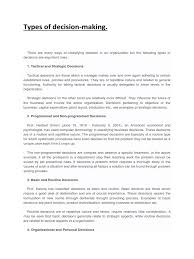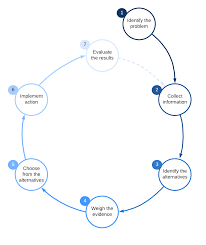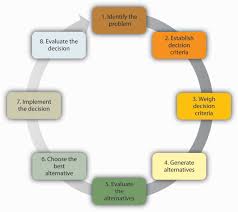Management Decisions: Examples of Effective Decision-Making in the Business World
In the fast-paced and ever-changing world of business, effective decision-making is crucial for success. Managers are faced with numerous choices on a daily basis, and their decisions can have a significant impact on the organization’s performance and future prospects. Let’s explore some examples of management decisions that showcase the importance of sound decision-making in various business scenarios.
Strategic Expansion:
A company’s growth often hinges on strategic expansion decisions. For instance, a retail chain may analyze market trends and consumer demand to identify potential locations for new stores. By carefully considering factors such as demographics, competition, and profitability projections, managers can make informed decisions about where to expand their business.
Resource Allocation:
Effective resource allocation is vital for optimizing efficiency and maximizing productivity. Managers must decide how to allocate limited resources like budget, equipment, and human capital across different projects or departments. By analyzing data, assessing priorities, and considering potential risks, managers can make informed decisions that ensure resources are allocated optimally to achieve desired outcomes.
Hiring and Talent Management:
Recruiting and retaining top talent is crucial for organizational success. Managers play a pivotal role in making hiring decisions that align with the company’s goals and values. They must evaluate candidates’ qualifications, cultural fit, potential for growth, and overall contribution to the team dynamics. Making sound hiring decisions helps build a talented workforce that drives innovation and achieves business objectives.
Product Development:
Innovation is key to staying competitive in today’s dynamic markets. Managers must make critical decisions regarding product development strategies – from identifying new market opportunities to determining features that align with customer needs. By conducting market research, analyzing consumer feedback, and assessing technological advancements, managers can make informed choices that lead to successful product launches.
Crisis Management:
Crises are inevitable in any organization – be it a natural disaster or a reputational issue. Effective crisis management requires quick decision-making under pressure. Managers must assess the situation, gather relevant information, and develop strategies to mitigate the impact. Decisions made during crises can significantly impact the organization’s reputation, stakeholder trust, and long-term viability.
Performance Evaluation and Feedback:
Managers are responsible for evaluating employee performance and providing constructive feedback. These decisions influence employee morale, engagement, and career growth. By using objective criteria, providing regular feedback, and setting clear expectations, managers can make fair decisions that motivate employees to excel.
In conclusion, effective decision-making is a critical skill for managers in today’s business landscape. By considering factors such as strategic expansion, resource allocation, talent management, product development, crisis management, and performance evaluation – managers can make informed decisions that drive organizational success. Through careful analysis of data, market trends, and stakeholder input – managers can navigate complex business environments with confidence and achieve desired outcomes for their organizations.
6 Essential Tips for Effective Management Decision-Making
- Identify the problem or opportunity
- Consider all options
- Involve key stakeholders
- Analyze the risks and rewards
- Set clear expectations
- Monitor progress
Identify the problem or opportunity
Identify the Problem or Opportunity: A Crucial Step in Effective Management Decision-Making
In the realm of management decision-making, one of the fundamental steps is to identify the problem or opportunity at hand. This initial stage sets the foundation for the entire decision-making process and plays a crucial role in determining the ultimate success or failure of a managerial decision.
When faced with a challenge or an opportunity, it is essential for managers to first clearly define and understand what they are dealing with. This involves carefully analyzing the situation, gathering relevant information, and asking pertinent questions. By taking the time to identify and define the problem or opportunity, managers can gain valuable insights that will guide them towards making informed decisions.
Identifying a problem requires recognizing that something is amiss or not functioning optimally within an organization. It could be a decline in sales, operational inefficiencies, customer complaints, or any other issue that hinders progress. By pinpointing the specific problem, managers can focus their efforts on finding effective solutions that address its root cause rather than merely treating symptoms.
On the other hand, identifying an opportunity means recognizing potential avenues for growth, improvement, or innovation within the organization. It could be a gap in the market, emerging trends, technological advancements, or untapped resources waiting to be leveraged. Identifying opportunities allows managers to capitalize on favorable circumstances and make strategic decisions that propel their organization forward.
By dedicating time and effort to identify problems or opportunities accurately, managers set themselves up for success in subsequent stages of decision-making. They can then proceed to gather relevant data, analyze potential risks and benefits, explore alternative options, and ultimately make well-informed choices that align with organizational goals.
Moreover, identifying problems or opportunities promotes transparency within an organization. It encourages open communication among team members and stakeholders as they collectively work towards finding solutions or capitalizing on new possibilities. This collaborative approach fosters a sense of ownership and commitment among employees, leading to more effective implementation of decisions.
In conclusion, the initial step of identifying the problem or opportunity is a critical aspect of effective management decision-making. By taking the time to clearly define the challenge at hand or recognizing potential areas for growth, managers can lay a strong foundation for their decision-making process. This step enables them to gather relevant information, explore alternatives, and ultimately make informed choices that drive positive outcomes for their organization.
Consider all options
Consider All Options: A Key Tip for Effective Management Decisions
When it comes to making important management decisions, considering all available options is a fundamental step towards achieving successful outcomes. In the fast-paced and competitive business world, managers are often faced with complex choices that can have far-reaching implications for their organizations. By taking the time to explore and evaluate all possible options, managers can make informed decisions that lead to positive results.
One of the biggest pitfalls in decision-making is rushing into a choice without fully understanding the range of possibilities. It’s easy to fall into the trap of assuming that there are only a few viable options or sticking with familiar approaches. However, this limited mindset can hinder growth and innovation. By consciously expanding the scope of consideration, managers open themselves up to new ideas, perspectives, and potential solutions.
Considering all options involves conducting thorough research and gathering relevant information. This may include analyzing market trends, studying industry best practices, seeking input from team members or experts in the field, and even exploring unconventional approaches. The goal is to broaden the decision-making landscape and uncover alternative paths that may have been overlooked initially.
Taking the time to consider all options also helps in identifying potential risks and benefits associated with each choice. By carefully weighing pros and cons, managers can make more balanced decisions that minimize potential pitfalls while maximizing opportunities for success. This comprehensive approach allows for a more holistic evaluation of each option’s feasibility, impact on resources, alignment with organizational goals, and potential long-term consequences.
Furthermore, considering all options fosters a culture of inclusivity within an organization. By involving team members at different levels and departments in decision-making processes, managers tap into a diverse range of perspectives and expertise. This collaborative approach not only enhances problem-solving but also boosts employee engagement and morale as individuals feel valued for their contributions.
In conclusion, considering all available options is an essential tip for effective management decision-making. By expanding horizons beyond initial assumptions, conducting thorough research, and involving diverse perspectives, managers can make informed choices that lead to positive outcomes. Embracing this approach fosters innovation, minimizes risks, and ensures that decisions align with organizational goals. So the next time you’re faced with a critical decision, remember to take the time to consider all options – the results might just exceed your expectations.
Involve key stakeholders
One crucial tip for effective management decision-making is to involve key stakeholders in the process. When making important decisions that impact the organization, it is essential to consider the perspectives and input of those who are directly affected or have a vested interest in the outcome.
Involving key stakeholders brings several benefits. Firstly, it helps gather diverse viewpoints and expertise, leading to more well-rounded decision-making. Each stakeholder brings unique insights based on their roles, responsibilities, and experiences within the organization. By involving them, managers can tap into a wealth of knowledge that may uncover potential risks, opportunities, or alternative solutions that might otherwise be overlooked.
Secondly, involving stakeholders fosters a sense of ownership and buy-in. When individuals feel that their voices are heard and their opinions are considered, they become more invested in the decision’s success. This engagement can lead to increased commitment and motivation from stakeholders as they work towards implementing the chosen course of action.
Furthermore, involving key stakeholders promotes transparency and trust within the organization. When managers actively seek input from those affected by a decision, it demonstrates respect for their expertise and demonstrates an inclusive leadership style. This approach builds trust among team members and promotes open communication channels where concerns or objections can be raised and addressed constructively.
However, it’s important to note that involving stakeholders does not mean giving everyone equal decision-making power or trying to please everyone at all costs. The ultimate responsibility for making decisions lies with management. Involving stakeholders is about gathering information, perspectives, and feedback to make informed choices that align with organizational goals.
To effectively involve key stakeholders in decision-making processes:
- Identify relevant stakeholders: Determine who will be directly impacted by the decision or has valuable insights to contribute.
- Communicate clearly: Clearly communicate the purpose of involving stakeholders and explain how their input will be used in the decision-making process.
- Create an inclusive environment: Foster an atmosphere where all participants feel comfortable sharing their perspectives and ideas. Encourage open dialogue and active listening.
- Consider different viewpoints: Analyze the input received from stakeholders, considering the pros and cons of each perspective. Look for common themes or areas of agreement/disagreement.
- Make an informed decision: Use the information gathered from stakeholders, along with other relevant data, to make a well-informed decision that takes into account multiple perspectives.
By involving key stakeholders in management decision-making, organizations can harness the collective wisdom and expertise of their team members, leading to better decisions, increased stakeholder buy-in, improved trust, and ultimately, greater success in achieving organizational goals.
Analyze the risks and rewards
When it comes to making management decisions, one crucial tip is to analyze the risks and rewards involved. Every decision carries a certain level of uncertainty, and understanding the potential risks and rewards is essential for effective decision-making.
Analyzing risks involves identifying potential obstacles or challenges that could arise from a particular decision. This could include financial risks, operational risks, or even reputational risks. By evaluating these potential pitfalls, managers can develop strategies to mitigate or minimize them. It allows them to make informed choices that balance the potential rewards with the associated risks.
On the other hand, analyzing rewards helps managers assess the potential benefits and positive outcomes of a decision. This includes considering financial gains, increased market share, improved efficiency, or enhanced customer satisfaction. Understanding the potential rewards allows managers to prioritize decisions and focus on those that offer the greatest value to their organization.
By carefully weighing both the risks and rewards, managers can make more informed decisions that align with their organization’s goals and values. It helps them identify potential roadblocks while also recognizing opportunities for growth and success.
Moreover, analyzing risks and rewards enables managers to develop contingency plans in case unexpected challenges arise. It allows for better preparation and adaptability when faced with unforeseen circumstances.
In conclusion, analyzing the risks and rewards associated with management decisions is an essential practice for effective decision-making. By thoroughly evaluating both aspects, managers can make informed choices that strike a balance between taking calculated risks and maximizing potential rewards. This approach not only increases the likelihood of successful outcomes but also strengthens an organization’s ability to navigate uncertainties in an ever-changing business landscape.
Set clear expectations
Setting Clear Expectations: A Key Tip for Effective Management Decisions
In the realm of management, one of the most crucial tips for making effective decisions is setting clear expectations. As a manager, your ability to clearly communicate your expectations to your team members plays a significant role in achieving desired outcomes and fostering a productive work environment.
When expectations are vague or poorly communicated, it can lead to confusion, misunderstandings, and ultimately hinder progress. On the other hand, setting clear expectations provides your team with a clear roadmap for success and empowers them to perform at their best. Let’s delve into why setting clear expectations is so important in management decision-making.
Firstly, clear expectations provide clarity on goals and objectives. When team members understand what is expected of them, they can align their efforts accordingly. This clarity helps them prioritize tasks, allocate resources effectively, and work towards shared goals. By clearly outlining the desired outcomes, you create a sense of purpose and direction within your team.
Secondly, setting clear expectations promotes accountability. When everyone knows what is expected of them individually and as a team, it becomes easier to hold each other accountable for their performance. Clear expectations establish a framework for evaluating progress and results. It allows managers to provide constructive feedback based on objective criteria rather than subjective judgment.
Moreover, setting clear expectations fosters open communication. When team members know what is expected of them, they feel more comfortable seeking clarification or sharing concerns regarding their workload or challenges they may face. This open dialogue creates an environment where issues can be addressed promptly and collaboratively.
Lastly, clear expectations contribute to employee engagement and job satisfaction. When employees have a clear understanding of their roles and responsibilities, they feel empowered to take ownership of their work. They can see how their contributions fit into the bigger picture and understand the impact they have on the organization’s success.
To set clear expectations effectively as a manager, consider these steps:
- Clearly define and communicate the desired outcomes and objectives of a project or task.
- Break down expectations into specific, measurable, achievable, relevant, and time-bound (SMART) goals.
- Provide clear guidelines on timelines, deadlines, and any specific requirements.
- Encourage open communication and address any questions or concerns promptly.
- Regularly assess progress and provide feedback to ensure alignment with expectations.
In conclusion, setting clear expectations is a fundamental tip for effective management decision-making. By doing so, you provide your team with a clear sense of direction, promote accountability, foster open communication, and enhance employee engagement. When expectations are well-defined and effectively communicated, you pave the way for success in achieving desired outcomes and creating a positive work environment for your team.
Monitor progress
Monitoring Progress: A Key Element in Effective Management Decision-Making
In the realm of management decision-making, one crucial tip that often gets overlooked is the importance of monitoring progress. Making a decision is just the first step; ensuring its successful implementation requires ongoing evaluation and tracking of results. Let’s delve into why monitoring progress is a vital element in effective management decision-making.
When managers make decisions, they set goals and establish strategies to achieve them. However, without actively monitoring progress, it becomes challenging to determine whether those decisions are yielding the desired outcomes. Monitoring allows managers to assess whether their decisions are on track or if adjustments need to be made.
Regularly monitoring progress provides valuable insights into the effectiveness of implemented decisions. It helps identify potential bottlenecks or areas where improvements can be made, allowing managers to take corrective action promptly. By closely tracking progress, managers can identify any deviations from the intended course and make necessary adjustments to ensure goals are met.
Monitoring progress also enables managers to gather data and metrics that provide a clear picture of how well a decision is performing. This data-driven approach allows for objective evaluation rather than relying solely on subjective assessments. By analyzing relevant data, managers can make informed decisions about whether to continue with current strategies or explore alternative approaches.
Furthermore, monitoring progress fosters accountability within an organization. When employees know that their work is being monitored and evaluated regularly, they are more likely to stay focused and motivated towards achieving desired outcomes. It creates a sense of responsibility and encourages individuals to take ownership of their tasks, ultimately driving overall performance.
In addition, monitoring progress allows for timely recognition of successes and milestones achieved along the way. Celebrating achievements not only boosts morale but also reinforces positive behaviors and encourages employees to continue working towards organizational goals.
To effectively monitor progress, managers should establish clear metrics and milestones that align with the goals set during the decision-making process. Regular check-ins, performance reviews, and data analysis should be conducted to assess progress objectively. Leveraging technology and automation tools can also streamline the monitoring process, providing real-time updates and insights.
In conclusion, monitoring progress is a crucial aspect of effective management decision-making. By actively tracking progress, managers can evaluate the success of their decisions, make necessary adjustments, and ensure that goals are being met. It promotes accountability, data-driven evaluation, and recognition of achievements. So remember, when making decisions as a manager, don’t forget to monitor progress – it’s an essential ingredient for success.





Wow, amazing blog layout! How lengthy have you ever been blogging for?
you make blogging look easy. The full glance of your website is great, let alone the content material!
You can see similar: sklep internetowy
and here e-commerce
Thank you for your positive feedback on our blog layout! We’re glad you find the content engaging. While we appreciate your suggestions for other websites, our focus remains on discussing management decision examples in the business world. Feel free to explore more of our articles on effective decision-making in various business scenarios.